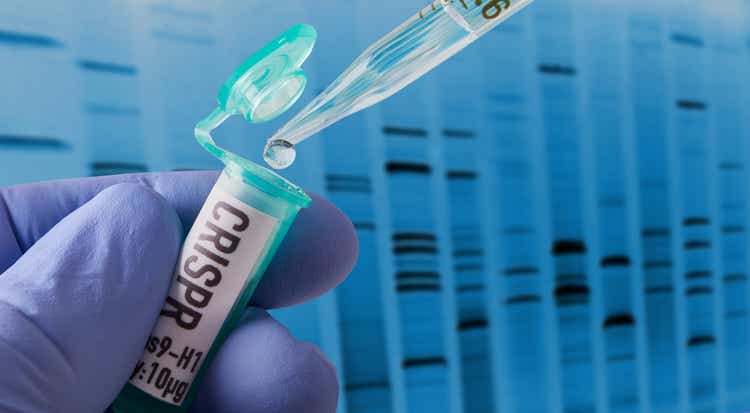
The Revolutionary CASGEVY Approval
CASGEVY, a pioneering gene therapy developed by CRISPR Therapeutics AG (CRSP) and Vertex (VRTX), brings hope for patients battling sickle cell disease (SCD). This therapy is specifically designed for individuals aged 12 and older who experience frequent vaso-occlusive crises (VOCs).
The primary issue in sickle cell disease is a mutation in hemoglobin, the protein in red blood cells responsible for oxygen delivery. This mutation causes the cells to adopt a crescent or “sickle” shape, leading to restricted blood flow and reduced oxygen delivery, resulting in severe pain and potential organ damage. The condition, predominantly affecting African Americans, is a significant health concern, impacting around 100,000 people in the U.S.
CASGEVY’s approach involves modifying the patient’s own hematopoietic (blood) stem cells using CRISPR/Cas9 technology. This gene-editing tool is directed to cut DNA in specific areas, allowing for precise DNA editing. The edited blood stem cells, once reintroduced into the patient, engraft within the bone marrow and enhance the production of fetal hemoglobin (HbF).
This type of hemoglobin, prevalent during fetal development, is more effective than its adult counterpart and can prevent the sickling of red blood cells in SCD patients. The treatment process is comprehensive and involves several steps. Initially, a mobilization medicine is administered to move blood stem cells from the bone marrow into the bloodstream. These cells are then collected and sent to a manufacturing site to create CASGEVY. This phase can take up to six months.
Following this, patients undergo a conditioning regimen in the hospital to prepare their bone marrow for the modified cells. The CASGEVY infusion is then administered intravenously. Post-infusion, patients remain hospitalized for close monitoring, which can last from four to six weeks.
The most common side effects of CASGEVY include low levels of platelets and white blood cells, which can lead to increased risk of bleeding and infection. Patients are advised not to donate blood, organs, tissues, or cells after receiving the treatment.
Enhancing the Conditioning Agent for Short-Term Gains
Enhancing the conditioning agent used in the treatment process for therapies like CASGEVY could unlock significant advancements. The conditioning process, particularly when it involves chemotherapy-like protocols, is a critical step in preparing a patient’s body for the acceptance and integration of genetically modified cells. A gentler conditioning agent could potentially make the therapy accessible to a broader range of patients. Currently, the intensity of the conditioning regimen limits the eligibility of patients, particularly those who may not be able to tolerate the harsh effects of chemotherapy-like treatments.
A less toxic conditioning regimen could be safer for a wider range of patients, including those with comorbidities or those who are in a weaker health state. The toxicity associated with current conditioning methods can lead to a range of side effects, from infections to organ damage. A more targeted and less toxic conditioning agent could reduce these risks, leading to a safer overall treatment experience. By minimizing the potential for complications during the conditioning phase, the overall success rates of gene therapy treatments like CASGEVY could be improved.
Reducing the intensity and toxicity of the conditioning regimen could also lead to a better quality of life for patients both during and after treatment. This includes a shorter recovery time and less time spent managing the side effects of conditioning. At the JP Morgan Healthcare conference, Sam Kulkarni (CRISPR Therapeutics CEO), said the company is working on a new conditioning agent that might unlock the therapy to triple of the current eligible population.
Evolving in the Medium to Long Term
In the medium to long term, the innovation leap will be to focus on developing in vivo editing techniques for hematopoietic stem cells (HSCs) within the bone marrow. The goal is to create delivery systems that can edit these HSCs directly in the patient’s body (“in situ”). In the JP Morgan conference, CRISPR’s CEO stated that this approach aims to make treatment accessible to the approximately 1 million sickle cell patients worldwide who cannot afford the current form of CASGEVY. This also unlocks other therapeutical applications, such as the development of highly sophisticated CAR-T (Chimeric Antigen Receptor T-cell) therapies targeting CD19 and CD70.
It’s clear that gene therapies like CASGEVY are not just about treating diseases; they are about changing lives and redefining what was once deemed incurable. The potential for not just alleviating pain, but for restoring hope and quality of life is immeasurable. These innovative solutions could well bring about a revolution in the way we approach and treat diseases, setting a new precedent for medical care and instilling optimism in the hearts of millions.


